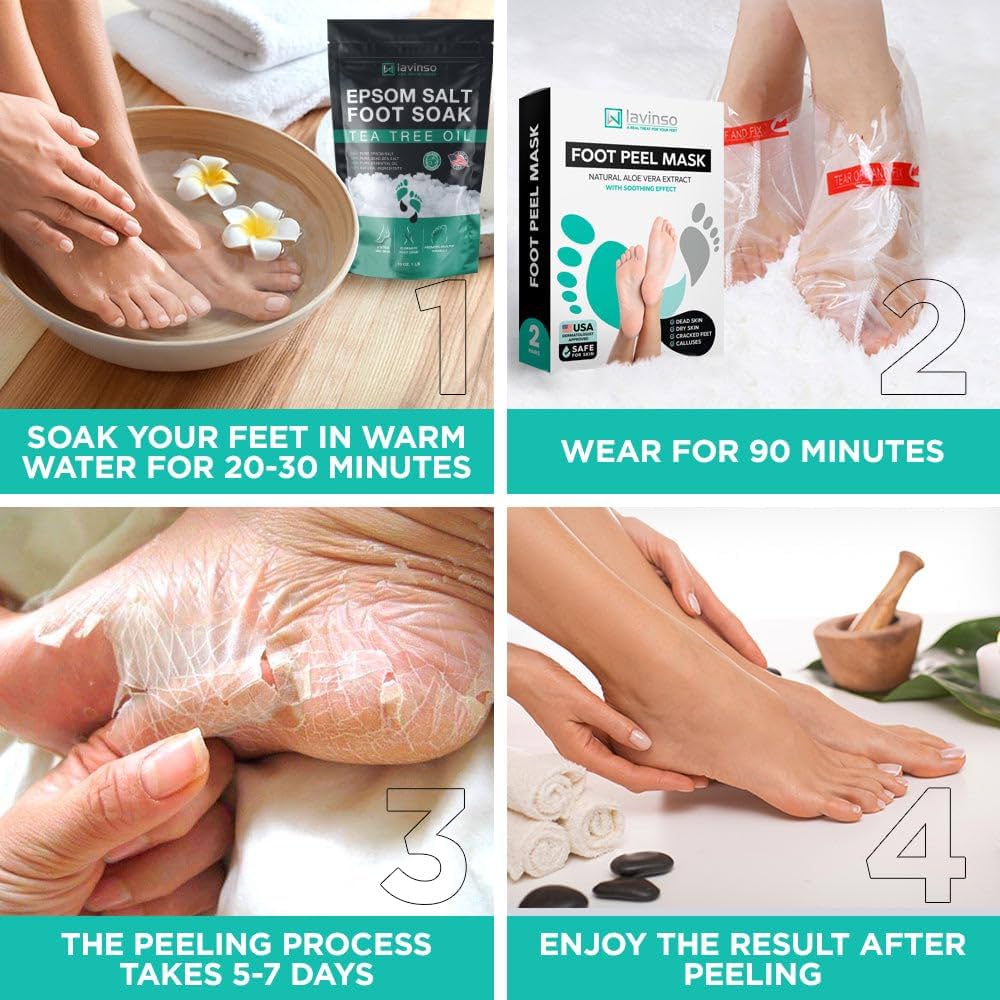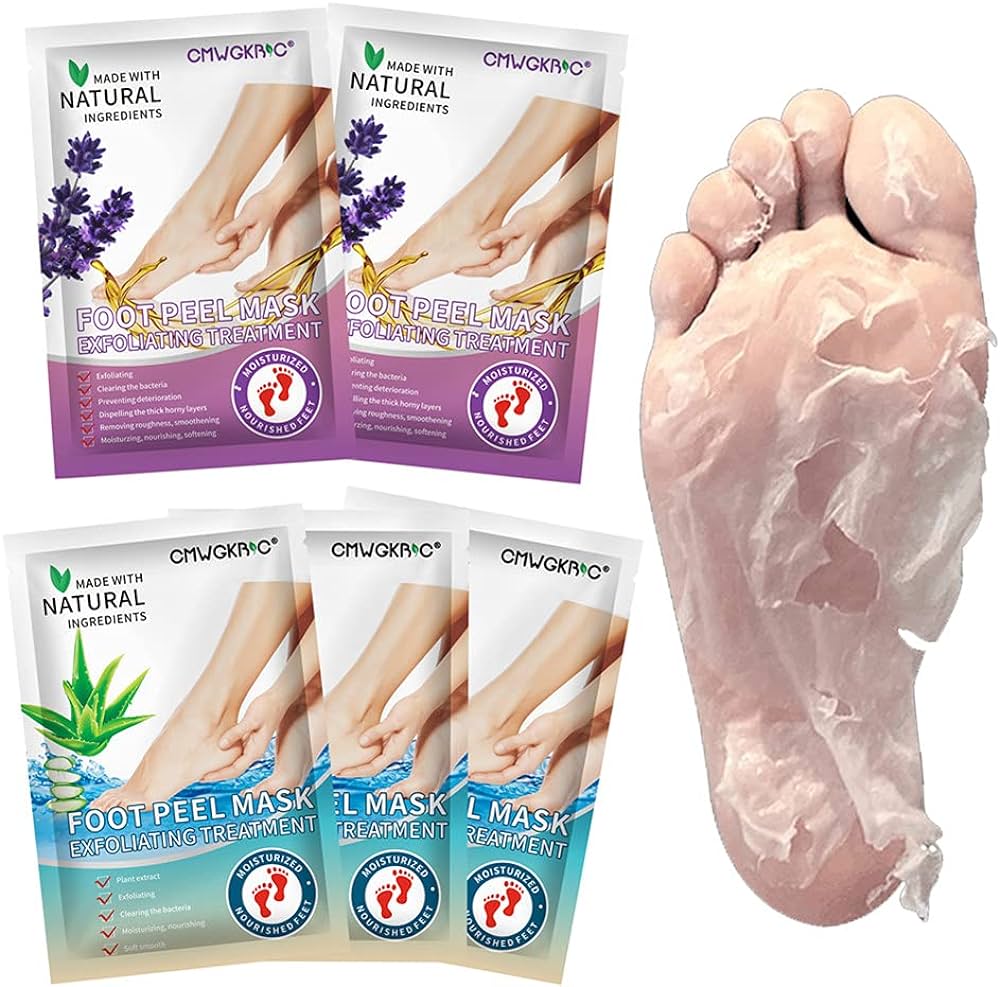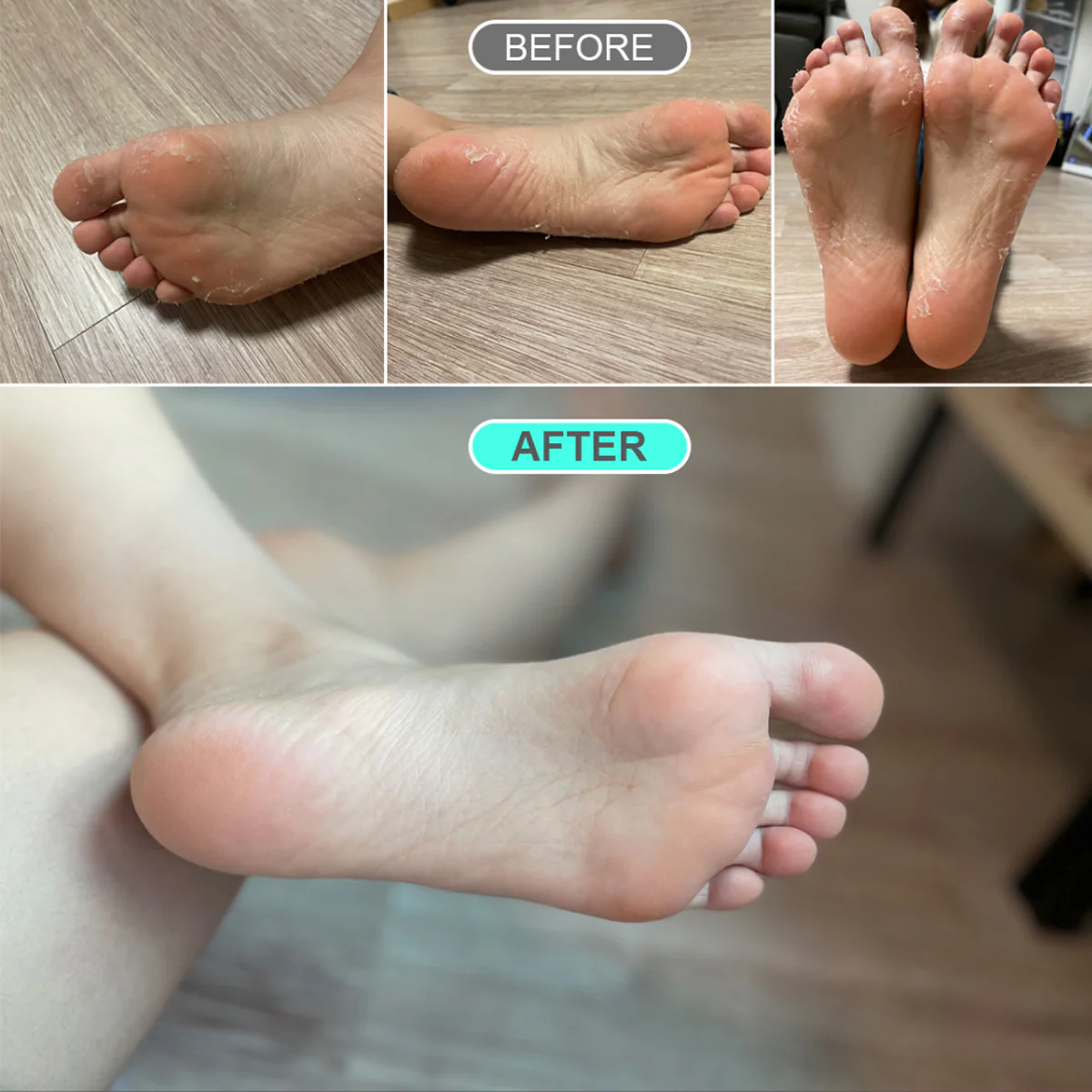Foot Masks and Peels: Top Intensive Masks & Peels for Softer, Renewed Skin (2025 Guide)
Discover the benefits of foot masks and peels, intensive treatments for renewing and softening rough feet. Learn how to get spa-like results at home. Enhance your foot care routine today!
Are your feet craving some serious TLC? I’ve got just the solution for you: foot masks and peels. These intensive treatments are revolutionizing at-home foot care, offering a spa-like experience that softens and renews even the toughest, most neglected feet.
I’ve tried countless foot care products over the years, but nothing compares to the groundbreaking power of these masks and peels. They’re designed to slough away dead skin, soften calluses, and reveal baby-smooth feet underneath. Whether you’re dealing with rough heels, dry patches, or just want to pamper your hardworking feet, these treatments can work wonders.
In this text, I’ll jump into the industry of foot masks and peels, exploring their benefits, how they work, and which products stand out from the crowd. Get ready to step into a new area of foot care that’ll leave you walking on cloud nine.
Understanding Foot Masks and Peels
Foot masks and peels are intensive treatments designed to soften, renew, and improve the overall health of your feet’s skin. These products offer a spa-like experience at home, targeting common foot issues like rough patches, calluses, and dry skin.
Key Ingredients and Mechanisms
Foot masks and peels rely on powerful exfoliating agents to deliver results:
- Alpha-hydroxy acids (AHAs): Glycolic acid and lactic acid
- Beta-hydroxy acids (BHAs): Salicylic acid
- Other acids: Citric acid
These ingredients work together to dissolve dead skin cells and promote cell turnover, revealing smoother, softer feet underneath. Many products also incorporate fruit enzymes and botanical extracts to enhance exfoliation and provide additional moisturizing benefits.
Application and Usage
Using foot masks and peels is a straightforward process:
- Products come in disposable booties or sock-style masks
- Slip your feet into the booties
- Leave them on for approximately 60 minutes
- Wash your feet thoroughly after treatment
- Soak feet in warm water daily to aid the peeling process
The peeling effect typically begins 3-5 days after the initial application and can last up to two weeks. During this time, dead skin will gradually slough off, revealing renewed, baby-soft feet.
By understanding the science behind foot masks and peels, you can make informed decisions about incorporating these intensive treatments into your foot care routine. Regular use can lead to smoother, healthier-looking feet, especially when combined with proper moisturizing and maintenance.
Types of Intensive Foot Treatments
Intensive foot treatments offer powerful answers for transforming dry, rough feet into soft, smooth soles. These treatments come in various forms, each designed to target exact foot care concerns.
Exfoliating Peels
Exfoliating peels are the powerhouse of foot treatments, providing dramatic results for rough, calloused feet. These peels typically come in bootie or sock-style masks filled with a potent blend of exfoliating agents. Here’s what you need to know:
- Application: Wear the booties for about 60 minutes, then rinse.
- Key ingredients: Alpha-hydroxy acids (AHAs) like glycolic and lactic acid, beta-hydroxy acids (BHAs), and fruit enzymes.
- Peeling process: Begins 3-14 days post-application, lasting up to two weeks.
- Results: Layers of dead skin slough off, revealing softer, smoother feet.
Hydrating Masks
Hydrating foot masks focus on nourishing and moisturizing dry, cracked skin. These treatments provide intense hydration to rejuvenate tired feet:
- Format: Sheet masks, cream masks, or gel socks infused with moisturizing ingredients.
- Key ingredients: Hyaluronic acid, glycerin, shea butter, and natural oils.
- Application time: Usually 15-30 minutes, with some overnight options.
- Benefits: Deep hydration, softer skin, and improved foot texture.
- Frequency: Can be used weekly or as needed for maintenance.
- Types: Scrubs, chemical peels, and intensive creams.
- Key ingredients: Urea, salicylic acid, and natural exfoliants like pumice.
- Application: Varies by product, from quick scrubs to overnight treatments.
- Benefits: Removes dead skin, softens calluses, and improves overall foot health.
- Results: Smoother, younger-looking feet with improved texture and appearance.
- Maintenance: Regular use can help prevent the buildup of rough, dry skin.

Benefits of Foot Masks and Peels
Foot masks and peels offer intensive treatments that effectively soften and renew tired, neglected feet. These powerful products provide a range of benefits that can significantly improve the overall health and appearance of your feet.
Softening Rough Skin
Foot masks and peels excel at softening rough, dry skin on the feet. They contain potent moisturizing ingredients like shea butter, coconut oil, and hyaluronic acid that penetrate deep into the skin, hydrating and smoothing even the toughest calluses.
For example, the Que Bella Intensive Foot Mask uses apple extract and shea butter to transform dry, cracked heels into silky-smooth skin. Regular use of these treatments can help maintain soft, supple feet and prevent the buildup of rough patches.
Removing Dead Skin Cells
One of the primary functions of foot masks and peels is their ability to remove dead skin cells through exfoliation. These products often contain alpha-hydroxy acids (AHAs) and beta-hydroxy acids (BHAs), such as glycolic acid, salicylic acid, and lactic acid. These powerful exfoliants work by dissolving the bonds between dead skin cells, allowing them to slough off easily. The Patchology PoshPeel Pedi Cure, for instance, utilizes an AHA and BHA botanical blend to create a dramatic peeling effect over several days, revealing fresh, renewed skin underneath.
Improving Overall Foot Health
By softening rough skin and removing dead cells, foot masks and peels contribute to improved overall foot health. These treatments help increase circulation to the feet, promoting faster cell turnover and encouraging the growth of healthy new skin. Also, they can help reduce the occurrence of common foot problems such as calluses, corns, and cracked heels. Regular use of foot masks and peels can also enhance the effectiveness of other foot care products by allowing them to penetrate more deeply into the skin, maximizing their benefits and leaving your feet feeling rejuvenated and healthier.
How to Choose the Right Foot Treatment
Selecting the ideal foot mask or peel requires careful consideration of several factors. Here’s what to keep in mind when choosing an intensive foot treatment for softening and renewing your feet.
Skin Type Considerations
When choosing a foot mask or peel, I always consider my skin type. For sensitive skin, I opt for gentler, moisturizing masks rather than strong exfoliating peels. Those with normal to oily skin can typically tolerate more intensive treatments. If I have dry or cracked skin, I look for products with extra hydrating ingredients. For callused or extremely rough feet, I choose stronger exfoliating formulas designed to tackle tough skin. It’s crucial to match the treatment intensity to your skin’s needs to avoid irritation or ineffective results.
Ingredients to Look For
I pay close attention to the ingredients list when selecting foot masks and peels. For exfoliation, I look for alpha-hydroxy acids (AHAs) like glycolic or lactic acid, which effectively remove dead skin cells. Beta-hydroxy acids (BHAs) such as salicylic acid are great for deep pore cleansing. For hydration, I seek out ingredients like hyaluronic acid, shea butter, and coconut oil. Urea is excellent for softening rough patches. Natural extracts like aloe vera or chamomile can soothe and calm the skin. Always check for high-quality, proven ingredients that target your exact foot concerns.
Potential Allergies and Sensitivities
Before using any foot mask or peel, I carefully check for potential allergens or irritants. Common ingredients that may cause reactions include fragrances, essential oils, and preservatives. If I have known allergies, I avoid products containing those exact ingredients.
For sensitive skin, I steer clear of harsh chemicals or abrasive exfoliants. It’s wise to perform a patch test on a small area of skin before full application. If I experience any redness, itching, or discomfort during use, I immediately rinse off the product. Always prioritize safety and consult a dermatologist if you’re unsure about a product’s suitability for your skin.

Proper Application Techniques
Applying foot masks and peels correctly is crucial for achieving optimal results. Following these techniques ensures the treatment’s effectiveness and maximizes the benefits for your feet.
Preparation Steps
Before applying a foot mask or peel, thoroughly clean and dry your feet. Remove any nail polish and soak your feet in warm water for 10-15 minutes to soften the skin. Gently pat your feet dry with a clean towel. If using a foot peel like Baby Foot or Dermora Foot Peel Mask, avoid moisturizing your feet beforehand.
For hydrating masks, lightly exfoliate your feet with a pumice stone to enhance product absorption. Gather all necessary materials, including the mask or peel booties, scissors (if needed to adjust size), and tape or socks to secure the booties.
During Treatment
Slip your feet into the treatment booties, ensuring they fit snugly. Secure them with tape or wear socks over them to prevent leakage. For foot peels like Patchology PoshPeel Pedi Cure, wear the booties for the recommended time, typically 60 minutes. Hydrating masks may require 15-30 minutes of application.
During this time, relax and avoid walking around to maintain consistent contact between the product and your skin. If you experience any discomfort or irritation, remove the treatment immediately and rinse your feet with cool water.
Post-Treatment Care
After removing the mask or peel, gently rinse your feet with lukewarm water and pat them dry. For hydrating masks, massage any remaining product into your skin. With exfoliating peels, avoid moisturizing immediately after treatment to allow the active ingredients to continue working.
In the days following a peel, your feet may start to shed dead skin. Resist the urge to peel off loose skin; instead, let it fall off naturally. Soak your feet daily for 10 minutes to aid the peeling process. Apply a gentle moisturizer to keep your newly revealed skin hydrated and smooth.
Safety Precautions and Potential Side Effects
When using foot masks and peels for intensive treatments, it’s crucial to be aware of safety precautions and potential side effects. I’ve found that following these guidelines helps ensure a safe and effective experience.
Application and Usage
- Always follow the product instructions carefully. Most foot peels and masks require soaking your feet, applying the treatment for about 60 minutes, then rinsing and drying thoroughly.
- Wear the masks or booties as directed to prevent discomfort or skin irritation.
- Perform a patch test before full application, especially if you have sensitive skin or allergies.
- Skin Irritation and Redness: Some users experience mild skin irritation, redness, or itching due to active ingredients like AHAs and BHAs. This is more common in those with sensitive skin.
- Peeling and Shedding: The peeling process can be intense, lasting several days to a week after initial application. Don’t forcibly peel off loose skin during this time.
- Dryness: Some treatments may cause temporary dryness as dead skin cells are removed.
| Side Effect | Duration | Severity |
|---|---|---|
| Irritation | 1-3 days | Mild |
| Peeling | 5-7 days | Moderate |
| Dryness | 3-5 days | Mild |
To minimize risks, I recommend:
- Avoiding use on broken or irritated skin
- Not exceeding recommended treatment frequency
- Moisturizing feet regularly between treatments
- Discontinuing use if severe irritation occurs
By following these precautions and understanding potential side effects, you can safely enjoy the benefits of foot masks and peels for softer, renewed skin.
Natural vs. Chemical-Based Foot Treatments
Natural foot treatments offer a gentle approach to softening and renewing skin. Moisturizing masks, like the Aquaphor Repairing Foot Mask, use ingredients such as shea butter, avocado oil, provitamin B5, and bisabolol. These hydrating components provide intense moisturization without causing peeling, making them ideal for sensitive skin.
Plant-based foot peels incorporate natural ingredients like citrus fruit extracts, coconut oil, and sweet almond oil. The Boscia Fruit Acid Smoothing Foot Peel exemplifies this approach, using plant-derived ingredients to loosen dead skin cells and hydrate the feet. These treatments offer a more subtle exfoliation compared to chemical-based alternatives.
Chemical-based foot treatments, on the other hand, typically contain alpha-hydroxy acids (AHAs) or beta-hydroxy acids (BHAs). These powerful exfoliating agents work by dissolving the bonds between dead skin cells, promoting rapid cell turnover. The result is a more dramatic peeling effect, with visible shedding occurring within 3-5 days of application.
When choosing between natural and chemical-based treatments, consider your skin type and desired results. Natural options are gentler and better suited for sensitive skin or those seeking gradual improvement. Chemical-based treatments offer more intense exfoliation and faster results but may cause temporary skin sensitivity.
Both types of treatments can effectively soften and renew foot skin, targeting common issues like rough patches and dry skin. Regular use of either natural or chemical-based foot masks and peels can lead to smoother, healthier-looking feet when combined with proper foot care maintenance.
Frequency of Use for Optimal Results
I’ve found that the key to achieving optimal results with foot masks and peels lies in understanding the appropriate frequency of use. These intensive treatments are designed for periodic application rather than daily use. Most products recommend using them once every 2-4 weeks, allowing sufficient time for the skin to regenerate between treatments.
When using exfoliating foot peels, I’ve learned that it’s crucial to space out applications. These products, like the Patchology PoshPeel Pedi Cure, typically trigger a peeling process that begins 3-10 days after application and can last up to two weeks. Overusing these treatments can lead to excessive skin shedding and potential irritation.
For hydrating foot masks, I’ve noticed that they can be used more frequently, often once or twice a week, depending on your skin’s needs. These masks focus on nourishing and moisturizing rather than intense exfoliation, making them gentler on the skin.
It’s important to note that individual skin types and conditions may require adjustments to these general guidelines. I always recommend starting with less frequent use and gradually increasing as needed, paying close attention to how your skin responds.
Remember, consistency is key in maintaining soft, smooth feet. Regular use of foot masks and peels, combined with daily foot care routines, can help prevent the buildup of rough skin and keep your feet looking and feeling their best.
Complementary Foot Care Practices
To maximize the benefits of foot masks and peels, I’ve found that incorporating complementary foot care practices is essential. These additional treatments enhance the overall health and appearance of your feet, creating a comprehensive foot care routine.
Regular Exfoliation:
- Use a pumice stone or foot file 1-2 times weekly
- Gently scrub wet feet in circular motions
- Focus on areas prone to calluses and rough patches
Daily Moisturizing:
- Apply a rich foot cream or lotion immediately after showering
- Massage thoroughly, paying extra attention to heels and toes
- Look for ingredients like urea, glycerin, or hyaluronic acid
Foot Soaks:
- Soak feet in warm water with Epsom salts for 15-20 minutes
- Add a few drops of essential oils like lavender or tea tree for aromatherapy benefits
- Perform 1-2 times weekly to soften skin and reduce inflammation
Proper Nail Care:
- Trim toenails straight across to prevent ingrown nails
- Use a nail file to smooth edges
- Push back cuticles gently after soaking
Supportive Footwear:
- Wear well-fitting shoes with proper arch support
- Opt for breathable materials to reduce moisture buildup
- Rotate shoes regularly to allow them to dry completely
By incorporating these practices into your routine, you’ll enhance the effectiveness of foot masks and peels, maintaining softer, healthier feet between intensive treatments. Remember to tailor these practices to your exact needs and consult a podiatrist if you have any underlying foot conditions.
Conclusion
Foot masks and peels offer a groundbreaking approach to at-home foot care. These intensive treatments provide spa-like results addressing common issues like rough skin and calluses. By understanding the science behind these products choosing the right treatment and following proper application techniques you’ll achieve softer renewed feet. Remember to prioritize safety use them consistently and complement with daily foot care practices. I’ve found that incorporating foot masks and peels into my routine has revolutionized my foot care regimen. With regular use you too can enjoy healthier smoother feet that feel great and look even better.

